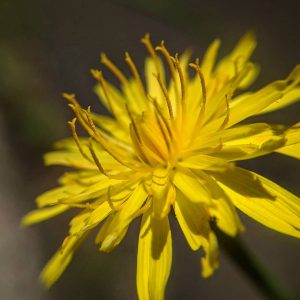Cat’s Ear or Flatweed (Hypochaeris radicata), a globalised temperate zone weed from Europe, and among the most prevalent weeds of Southeastern Australia. Superficially similar to Dandelion, it can be differentiated by the structure of the flower, its multiple arching flower stems, and its hairy leaves shaped and textured as indicated by its common name.
Cat’s Ear appears to have been first introduced to Australia through Victoria, where it was reported as suddenly common in the early 1870s, with the first available formal recordings made in 1874 at Yarra Flats near Heidelberg as well as at Corangamite in the Western District.
Cat’s Ear enjoyed a brief period of favour here as a presumed antidote to liver fluke in sheep, before being associated from the 1880s with stringhalt, a neurological condition in horses caused by a soil-borne fungus or mould which grows on the plant’s leaves. In Australia, the permanently damaged condition of many pastures and the drought cycle combine periodically to create favourable conditions for Cat’s Ear to become a dominant constituent in pasture biomass, allowing the fungal neurotoxin to be consumed by grazing horses at levels sufficient to cause temporary or even permanent damage. The first reporting of this connection (and first fatalities) occurred in 1885-86, at the end of the 1880-1886 drought when the return of good rains brought a bumper crop of Hypochaeris before anything else recovered in pastures across Victoria and NSW.
Within the metropolitan, a common weed of untended or disturbed lawns, slopes and waste places, but (like many plants) most stunning as a crack weed.
View Original Post on Instagram
Search for information about Hypochaeris radicata in the Flora of Victoria
View information and occurrences of Hypochaeris radicata on the Atlas of Living Australia











